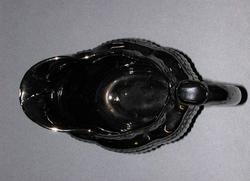Current Location: In storage
Titles
Silver lustre milk jug
Maker(s)
Unidentified factory
Entities
Categories
Description
Dark red-grey earthenware, moulded and dipped in silver (platinum) lustre.
Jug with oval body and loop handle, entirely covered in silver lustre. The sides are divided into three lobes on either side, with another under the lip, moulded with gadroons surrounding reserve panels. The handle has an eagle’s head as thumb piece. The underside is flat and lustred, with a narrow foot-rim.
Notes
History note: Bought with a matching coffee pot at Sotheby’s, Lot 376, on 4 November 1904, for 27/- (one pound seven shillings), by Dr J.W.L. Glaisher, Trinity College, Cambridge.
Legal notes
Dr J.W.L. Glaisher Bequest, 1928
Place(s) associated
Acquisition and important dates
Method of acquisition: Bequeathed
(1928)
by
Glaisher, J. W. L., Dr
Dating
19th Century, first half
Circa
1820
CE
-
1840
CE
Note
All over lustring was widely used to imitate Georgian silver, enabling the less well-off to enjoy ‘silver’ tea services, salt & pepper pots, candlesticks and similar items. From c1840, however, production dwindled with the introduction of relatively cheap electro-plating. Copper lustre coating was also popular in the 1830s, though was more often combined with other decorating techniques.
English lustreware was commercially produced from c.1805 and popular throughout the first half of the 19th Century. Staffordshire potters were the first and largest producers, though similar wares were also made in other regions and pink lustreware is often particularly associated with Sunderland. Minute amounts of gold were used to produce copper, gold, pink or purple lustre, depending on the type of clay, lustre formula, number of layers and firing temperature; platinum was used to mimic silver. Silver lustre was produced by dissolving platinum in aqua regia (nitric and hydrochloric acids) suspended in a resinous medium such as spirits of tar. Pots were dipped in the lustre solution to produce an even all-over coating and then fired at a low temperature, which burned the medium away to leave a ‘silver’ surface. Most lustreware was made for everyday use, and factory markings are rare.
This seems to have been a popular design. Dr Glaisher bought a similarly moulded coffee-pot at the same auction and, in 1908, a similarly moulded teapot.
Components of the work
Decoration
composed of
lustre
( silver (platinum))
Materials used in production
Earthenware
Techniques used in production
Moulding
: Earthenware, moulded and dipped in lustre.
Inscription or legends present
- Text: 'B'
- Location: Underside of base
- Method of creation: Moulded in relief
- Type: Mark
References and bibliographic entries
Related exhibitions
Identification numbers
Accession number: C.1173-1928
Primary reference Number: 71455
Old object number: 2158
Stable URI
Audit data
Created: Saturday 6 August 2011
Updated: Monday 29 April 2024
Last processed: Saturday 22 March 2025
Associated departments & institutions
Owner or interested party:
The Fitzwilliam Museum
Associated department:
Applied Arts






